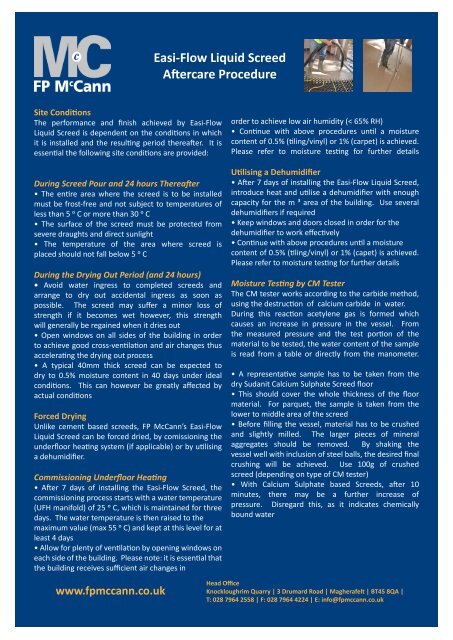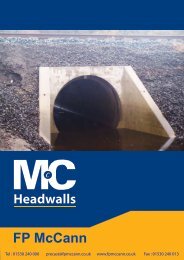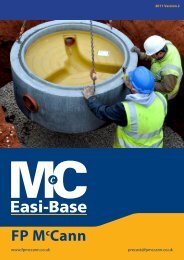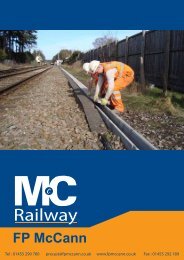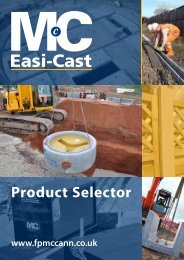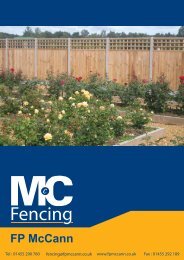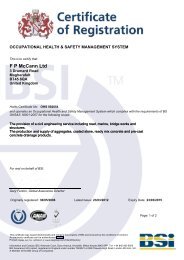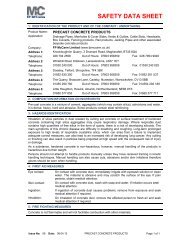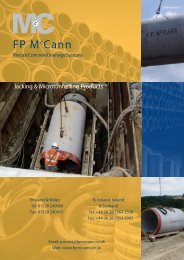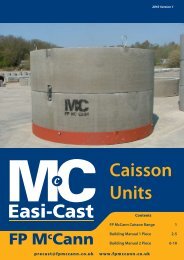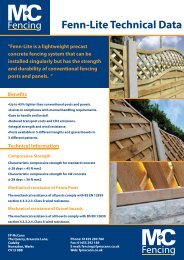Easi-Flow Liquid Screed Aftercare Procedure - FP McCann Ltd
Easi-Flow Liquid Screed Aftercare Procedure - FP McCann Ltd
Easi-Flow Liquid Screed Aftercare Procedure - FP McCann Ltd
- No tags were found...
You also want an ePaper? Increase the reach of your titles
YUMPU automatically turns print PDFs into web optimized ePapers that Google loves.
<strong>Easi</strong>-<strong>Flow</strong> <strong>Liquid</strong> <strong>Screed</strong><strong>Aftercare</strong> <strong>Procedure</strong>Site ConditionsThe performance and finish achieved by <strong>Easi</strong>-<strong>Flow</strong><strong>Liquid</strong> <strong>Screed</strong> is dependent on the conditions in whichit is installed and the resulting period thereafter. It isessential the following site conditions are provided:During <strong>Screed</strong> Pour and 24 hours Thereafter• The entire area where the screed is to be installedmust be frost-free and not subject to temperatures ofless than 5 o C or more than 30 o C• The surface of the screed must be protected fromsevere draughts and direct sunlight• The temperature of the area where screed isplaced should not fall below 5 o CDuring the Drying Out Period (and 24 hours)• Avoid water ingress to completed screeds andarrange to dry out accidental ingress as soon aspossible. The screed may suffer a minor loss ofstrength if it becomes wet however, this strengthwill generally be regained when it dries out• Open windows on all sides of the building in orderto achieve good cross-ventilation and air changes thusaccelerating the drying out process• A typical 40mm thick screed can be expected todry to 0.5% moisture content in 40 days under idealconditions. This can however be greatly affected byactual conditionsForced DryingUnlike cement based screeds, <strong>FP</strong> <strong>McCann</strong>’s <strong>Easi</strong>-<strong>Flow</strong><strong>Liquid</strong> <strong>Screed</strong> can be forced dried, by comissioning theunderfloor heating system (if applicable) or by utilisinga dehumidifier.Commissioning Underfloor Heating• After 7 days of installing the <strong>Easi</strong>-<strong>Flow</strong> <strong>Screed</strong>, thecommissioning process starts with a water temperature(UFH manifold) of 25 o C, which is maintained for threedays. The water temperature is then raised to themaximum value (max 55 o C) and kept at this level for atleast 4 days• Allow for plenty of ventilation by opening windows oneach side of the building. Please note: it is essential thatthe building receives sufficient air changes inorder to achieve low air humidity (< 65% RH)• Continue with above procedures until a moisturecontent of 0.5% (tiling/vinyl) or 1% (carpet) is achieved.Please refer to moisture testing for further detailsUtilising a Dehumidifier• After 7 days of installing the <strong>Easi</strong>-<strong>Flow</strong> <strong>Liquid</strong> <strong>Screed</strong>,introduce heat and utilise a dehumidifier with enoughcapacity for the m ³ area of the building. Use severaldehumidifiers if required• Keep windows and doors closed in order for thedehumidifier to work effectively• Continue with above procedures until a moisturecontent of 0.5% (tiling/vinyl) or 1% (capet) is achieved.Please refer to moisture testing for further detailsMoisture Testing by CM TesterThe CM tester works according to the carbide method,using the destruction of calcium carbide in water.During this reaction acetylene gas is formed whichcauses an increase in pressure in the vessel. Fromthe measured pressure and the test portion of thematerial to be tested, the water content of the sampleis read from a table or directly from the manometer.• A representative sample has to be taken from thedry Sudanit Calcium Sulphate <strong>Screed</strong> floor• This should cover the whole thickness of the floormaterial. For parquet, the sample is taken from thelower to middle area of the screed• Before filling the vessel, material has to be crushedand slightly milled. The larger pieces of mineralaggregates should be removed. By shaking thevessel well with inclusion of steel balls, the desired finalcrushing will be achieved. Use 100g of crushedscreed (depending on type of CM tester)• With Calcium Sulphate based <strong>Screed</strong>s, after 10minutes, there may be a further increase ofpressure. Disregard this, as it indicates chemicallybound waterwww.fpmccann.co.ukHead OfficeKnockloughrim Quarry | 3 Drumard Road | Magherafelt | BT45 8QA |T: 028 7964 2558 | F: 028 7964 4224 | E: info@fpmccann.co.uk
The requirements are for a maximum of 1% water byweight for moisture permeable floorings (e.g. carpets)and 0.5% water by weight for impermeablefloorings (e.g. vinyl, ceramic and stone). An electronic CMdevice is helpful to locate the highest moisture contentlocation by floor. The reading can then be confirmed bytesting to the carbide method.Moisture Testing by Hair Hygrometer (RH)The British Standard for testing a base to receive aresilient floor covering, is to use a hair hygrometer to themethod defined in BS8203: 2001. This provides a nondestructive test method and will give results for RelativeHumidity near to 75% (which is generally the requiredlimit for floor finishes). Above this level of moisture thehair hygrometer may not always provide a meaningfulreading. For correct results, the BS8023 method mustbe strictly adhered to, including the use of acorrectly sized and insulated box sealed to the floor, asufficiently long test for equilibrium to be reached and theuse (where appropriate) of an impervious sheet around theinstrument.PrimingIf a cement based adhesive or smoothing compound isrequired, the surface of the screed must first be sealedusing an appropriate acrylic primer/sealer as directed. Aminimum of 2 no. coats is essential.Surface DPM (Moisture Suppressing Membrane)In general, surface applied DPM systems do not stop thepassage of moisture, they actually allow the passage ofmoisture from the screed to the floor finishes, but at agreatly reduced and controlled rate. It will always be bestpractice and economical to dry the screed rather thanuse a surface DPM. However, due to time constraints orsite conditions, Sudanit Calcium Sulphate <strong>Screed</strong>s can becovered with a surface DPM, providing certain criteria aremet.Care must be taken regarding the amount ofmoisture trapped in the screed, as this will have an effecton the strength gain. Applying a moisture suppressingSurface DPM will effectively cap the strength of the screed,thus it should not be applied until the screed has gainedsufficient strength in order to install floor finishes.Without forced drying methods of the screed(as discussed earlier), we recommend the screed to beat least 4 weeks cured before applying a Surface DPM.Moisture content must be


